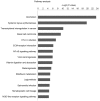Nuclear factor-κB signaling negatively regulates high glucose-induced vascular endothelial cell damage downstream of the extracellular signal-regulated kinase/c-Jun N-terminal kinase pathway
- PMID: 29042991
- PMCID: PMC5639326
- DOI: 10.3892/etm.2017.4999
Nuclear factor-κB signaling negatively regulates high glucose-induced vascular endothelial cell damage downstream of the extracellular signal-regulated kinase/c-Jun N-terminal kinase pathway
Erratum in
-
Erratum: Nuclear factor-κB signaling negatively regulates high glucose-induced vascular endothelial cell damage downstream of the extracellular signal-regulated kinase/c-Jun N-terminal kinase pathway.Exp Ther Med. 2018 Jan;15(1):606. doi: 10.3892/etm.2017.5422. Epub 2017 Nov 1. Exp Ther Med. 2018. PMID: 29388622 Free PMC article.
Abstract
Diabetes mellitus (DM)-induced high blood sugar severely damages vascular endothelial cells (VECs), which are in direct contact with the blood. Diabetic complications cause difficulties in skin wound healing and VECs are important for this process. Previous studies demonstrated that high blood sugar delayed the repair of wounded VECs, but the underlying mechanism has remained elusive. To explore the effects of diabetic conditions on VEC damage, cells were incubated in a medium with high glucose and then subjected to RNA-sequencing based transcriptome analysis. The results revealed that numerous biological processes were altered by HG stress, including extracellular matrix-receptor interaction, NOD-like receptor signaling and the nuclear factor (NF)-κB pathway. HG treatment increased the levels of phosphorylated inhibitor of NF-κB (IκB-α), the key NF-κB signaling regulator as well as the transcripts of plasminogen activator inhibitor-1 and interleukin-8, two inflammatory response markers. Treatment with extracellular signal-regulated kinase (ERK)- and c-Jun N-terminal kinase (JNK)-specific inhibitors U0126 and sp600125, respectively, led to the activation of IκB-α; however, the inhibitor of IκBα phosphorylation Bay11-7082 did not affect ERK and JNK activity, suggesting that ERK/JNK signaling occurs upstream of NF-κB in VECs. The present study provided useful information regarding the effects of diabetes on VECs, which may provide approaches for therapies of diabetes-associated complications in the future.
Keywords: damage; extracellular signal-regulated kinase/c-Jun N-terminal kinase; high glucose; nuclear factor-κB; vascular endothelial cell.
Figures



Similar articles
-
The activation of the NF-κB-JNK pathway is independent of the PI3K-Rac1-JNK pathway involved in the bFGF-regulated human fibroblast cell migration.J Dermatol Sci. 2016 Apr;82(1):28-37. doi: 10.1016/j.jdermsci.2016.01.003. Epub 2016 Jan 7. J Dermatol Sci. 2016. PMID: 26829882
-
Salvia miltiorrhiza polysaccharide activates T Lymphocytes of cancer patients through activation of TLRs mediated -MAPK and -NF-κB signaling pathways.J Ethnopharmacol. 2017 Mar 22;200:165-173. doi: 10.1016/j.jep.2017.02.029. Epub 2017 Feb 21. J Ethnopharmacol. 2017. PMID: 28232127
-
Apoptosis induced by trimethyltin chloride in human neuroblastoma cells SY5Y is regulated by a balance and cross-talk between NF-κB and MAPKs signaling pathways.Arch Toxicol. 2013 Jul;87(7):1273-85. doi: 10.1007/s00204-013-1021-9. Epub 2013 Feb 20. Arch Toxicol. 2013. PMID: 23423712
-
Postprandial lipoproteins and the molecular regulation of vascular homeostasis.Prog Lipid Res. 2013 Oct;52(4):446-64. doi: 10.1016/j.plipres.2013.06.001. Epub 2013 Jun 15. Prog Lipid Res. 2013. PMID: 23774609 Review.
-
The effect of reactive oxygen species on the synthesis of prostanoids from arachidonic acid.J Physiol Pharmacol. 2013 Aug;64(4):409-21. J Physiol Pharmacol. 2013. PMID: 24101387 Review.
Cited by
-
Effect of heme oxygenase 1 and renin/prorenin receptor on oxidized low-density lipoprotein-induced human umbilical vein endothelial cells.Exp Ther Med. 2019 Sep;18(3):1752-1760. doi: 10.3892/etm.2019.7769. Epub 2019 Jul 12. Exp Ther Med. 2019. PMID: 31410134 Free PMC article.
References
LinkOut - more resources
Full Text Sources
Other Literature Sources
Research Materials
Miscellaneous
